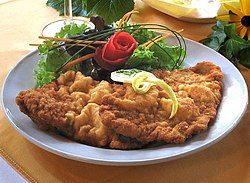This article includes a list of general references, but it lacks sufficient corresponding inline citations .(December 2021) |



Central European cuisine consists of the culinary customs, traditions and cuisines of the nations of Central Europe.
The cuisines within each country in the region is strongly influenced by the local climate. For example, German, Austrian and Swiss cuisines show many similarities, yet differ from the highlander cuisines in their respective countries, while in settlements closer to rivers or lakes, more fish and various seafood can be found more frequently. More mountainous areas near the Alps house dishes that contain cheese, milk and butter among other dairy products. [1]
While Czechia, Hungary, Poland, Slovakia and Slovenia are often geographically regarded as central European, their cuisines are considerably dissimilar to the cuisines of Austria, Germany and Switzerland. Czech, Lithuanian, Polish and Slovak cuisine are alternatively regarded as part of the eastern European culinary sphere due to strong East Slavic influences.
During the Bronze Age and Iron Age the basic foods were pulses, wild fruits and nuts, and cereals. Archaeobotanical evidence has shown that a large number of new foodstuffs were introduced to Central Europe under Roman rule, becoming incorporated into (rather than replacing) local culinary flavors. Because chickpeas, gourd, black pepper, pistachio, almond, dates, olives, melons and rice were difficult to cultivate locally they remained imported luxuries, out of reach for most. Evidence has been found for dill, celery seeds and other seasonings at Bibracte and other excavation sites. [2] [3]